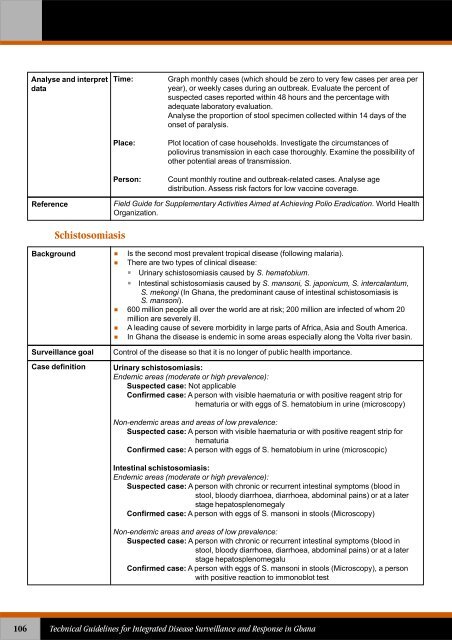Technical Guidelines for Integrated Disease Surveillance ... - PHRplus
Technical Guidelines for Integrated Disease Surveillance ... - PHRplus
Technical Guidelines for Integrated Disease Surveillance ... - PHRplus
You also want an ePaper? Increase the reach of your titles
YUMPU automatically turns print PDFs into web optimized ePapers that Google loves.
Analyse and interpretdataTime:Place:Person:Graph monthly cases (which should be zero to very few cases per area peryear), or weekly cases during an outbreak. Evaluate the percent ofsuspected cases reported within 48 hours and the percentage withadequate laboratory evaluation.Analyse the proportion of stool specimen collected within 14 days of theonset of paralysis.Plot location of case households. Investigate the circumstances ofpoliovirus transmission in each case thoroughly. Examine the possibility ofother potential areas of transmission.Count monthly routine and outbreak-related cases. Analyse agedistribution. Assess risk factors <strong>for</strong> low vaccine coverage.ReferenceField Guide <strong>for</strong> Supplementary Activities Aimed at Achieving Polio Eradication. World HealthOrganization.SchistosomiasisBackground Is the second most prevalent tropical disease (following malaria). There are two types of clinical disease:Urinary schistosomiasis caused by S. hematobium.Intestinal schistosomiasis caused by S. mansoni, S. japonicum, S. intercalantum,S. mekongi (In Ghana, the predominant cause of intestinal schistosomiasis isS. mansoni). 600 million people all over the world are at risk; 200 million are infected of whom 20million are severely ill. A leading cause of severe morbidity in large parts of Africa, Asia and South America.In Ghana the disease is endemic in some areas especially along the Volta river basin.<strong>Surveillance</strong> goalCase definitionControl of the disease so that it is no longer of public health importance.Urinary schistosomiasis:Endemic areas (moderate or high prevalence):Suspected case: Not applicableConfirmed case: A person with visible haematuria or with positive reagent strip <strong>for</strong>hematuria or with eggs of S. hematobium in urine (microscopy)Non-endemic areas and areas of low prevalence:Suspected case: A person with visible haematuria or with positive reagent strip <strong>for</strong>hematuriaConfirmed case: A person with eggs of S. hematobium in urine (microscopic)Intestinal schistosomiasis:Endemic areas (moderate or high prevalence):Suspected case: A person with chronic or recurrent intestinal symptoms (blood instool, bloody diarrhoea, diarrhoea, abdominal pains) or at a laterstage hepatosplenomegalyConfirmed case: A person with eggs of S. mansoni in stools (Microscopy)Non-endemic areas and areas of low prevalence:Suspected case: A person with chronic or recurrent intestinal symptoms (blood instool, bloody diarrhoea, diarrhoea, abdominal pains) or at a laterstage hepatosplenomegaluConfirmed case: A person with eggs of S. mansoni in stools (Microscopy), a personwith positive reaction to immonoblot test106<strong>Technical</strong> <strong>Guidelines</strong> <strong>for</strong> <strong>Integrated</strong> <strong>Disease</strong> <strong>Surveillance</strong> and Response in Ghana















